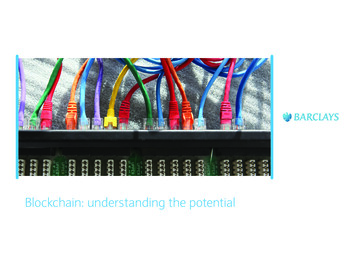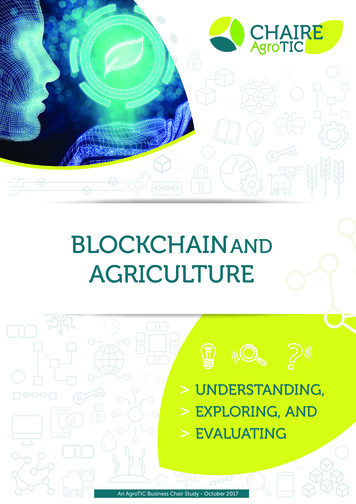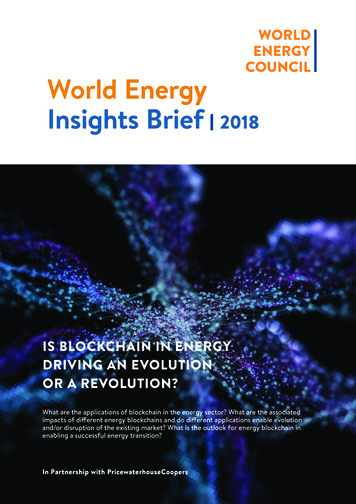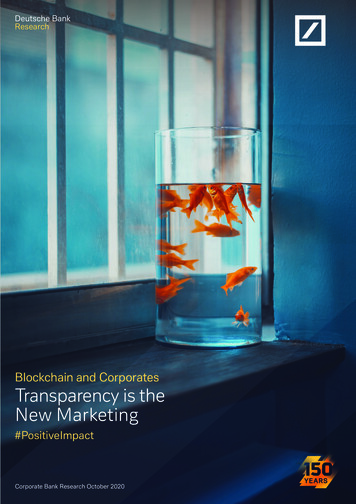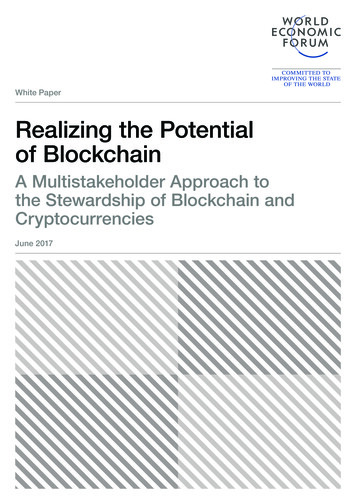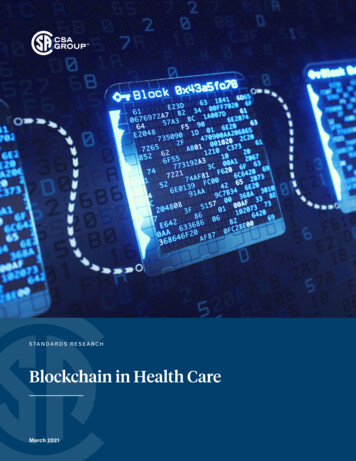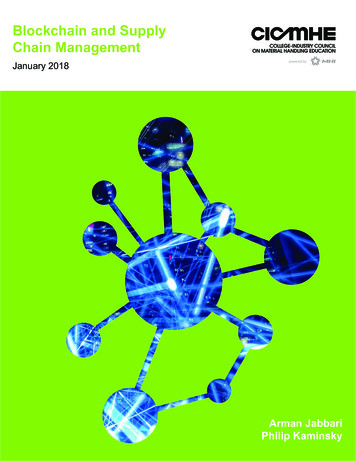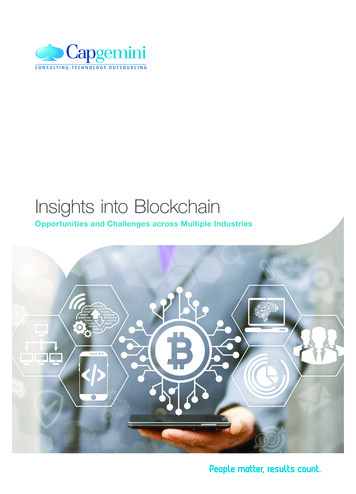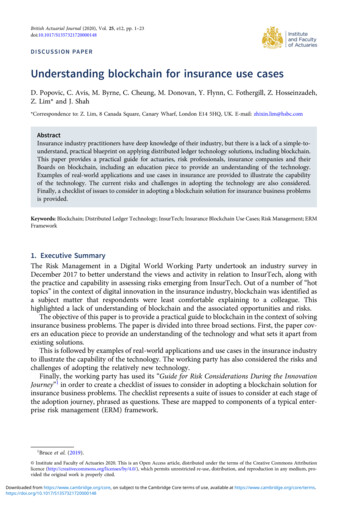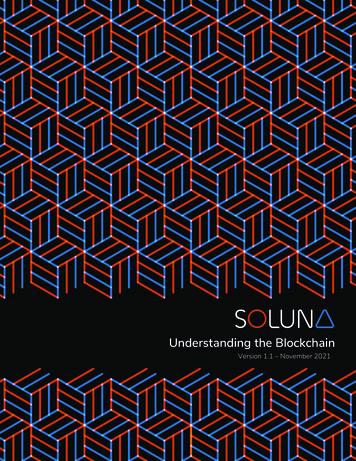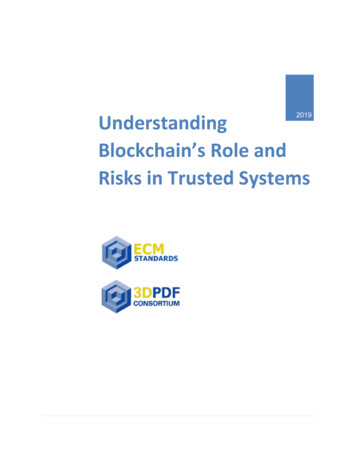
Transcription
UnderstandingBlockchain’s Role andRisks in Trusted Systems2019
Understanding Blockchain’s Role and Risks in Trusted SystemsContentsExecutive Summary3Introduction4Terms & Definitions5Concepts7Distributed Trust7Trusted Information8Trustworthiness of Systems8Trusted Systems9Off-chain Storage and Provenance9Blockchain and Sustainability10Blockchain Technology Modalities11Information Governance13Business Operations14Records Management15Blockchain integration for Records Management15Trustworthy Records15Immutable Records and DLT16Integration of records and information systems and DLT16Blockchain Records Management as a Service17Managing records created on a blockchain regardless of use case17Privacy (including GDPR)Challenges18Opportunities18Disposition19Use CasesElections Use Case1182020Problem Description20Business Challenge20Solution20Benefits22 Page 2019
Understanding Blockchain’s Role and Risks in Trusted SystemsImplementation ConsiderationsIdentity Management for Online Interactions Use Case2222Problem Description22Business Challenge22Solution23Benefits23Implementation Considerations23Supply Chain Management: Food Fraud Use Case23Problem Description23Business Challenge24Solution24Benefits24Implementation Considerations24Business Process Management/Workflow Automation & Blockchain25Business Challenges25Solution25Benefits25Implementation Considerations26Risk Considerations26Integration: Internet of Things and Blockchain26Business Challenge26Solution27Benefits27Implementation Considerations27Risk Considerations27Risk Implementation and Audit Considerations27Conclusion31Annex A32Annex B33Annex C35Bibliography/References43About 3D PDF Consortium47About White Paper Development/Approval Process472 Page 2019
Understanding Blockchain’s Role and Risks in Trusted SystemsExecutive SummaryWithout trust, our ability to engage in meaningful activities is diminished. However, distrust in societalinstitutions remains high despite recent gains. According to the 2019 Edelman Trust Barometer, trust insocietal institutions such as government, business, the media and non-governmental organizations(NGOs) rose 3 points between 2018 and 2019, but only 1 in 5 respondents believes the system isworking for them. According to an April 2019 report by the Pew Research Center, American trust ingovernment is near an all-time low with only 17 percent of Americans saying they can trust thegovernment in Washington to do what is right most of the time. The reasons for distrust are numerousand complex, but there’s a potential for blockchain distributed ledger technology to contribute to areversal of this trend. Today, entities worldwide are investigating the use of blockchain technologies tobuild trust with citizens and consumers, protect data, and reduce operating costs. This whitepaper, theresult of a year-long collaboration among representatives from the public and private sector, will helpthe reader understand the challenges, opportunities, benefits and risks of transferring trust frominstitutions to blockchain distributed ledger technology solutions.3 Page 2019
Understanding Blockchain’s Role and Risks in Trusted SystemsIntroductionThis document provides the layman with an introduction to the concept of trusted information inrelation to the use of blockchain technology as a form of Distributed Ledger Technologies (DLT). Itprovides guidance for Information Governance Professionals responsible for information assets withintheir organizations. This document defines the key characteristics of the current market as well asexisting challenges and opportunities. It provides industry information and analysis regarding thepotential use of DLT (aka blockchain for the purposes of this paper) for Elections, Identity Managementfor Online Transactions, Supply Chain Management/Food Fraud, Business Process/Workflow, andInternet of Things (IoT) use cases.This document should be used as an analytical resource for senior executives and informationgovernance professionals in business and government when investigating DLT, developing DLTstrategies, and / or planning DLT programs. It defines the key characteristics of the current market, aswell as existing challenges and opportunities (at the time of publication).This document does not suggest that Blockchain is a replacement for all enterprise systems, such asenterprise content management systems and trusted digital repositories. Instead, for the foreseeablefuture Blockchain will work alongside those types of products and provide additional capability.This is an evolving area where a great deal of work is taking place under the auspices of severalstandards’ development organizations.4 Page 2019
Understanding Blockchain’s Role and Risks in Trusted SystemsTerms & DefinitionsFor the purposes of this document, the following terms and definitions apply.Authenticationthe act of verifying identity.[SOURCE: ISO 16484-5:2017]Archival Sciencen., 1. The process of verifying that a thing is what it purports to be, that it is acceptable as genuine ororiginal.[SOURCE: SAA Glossary]Blockchaina digital database containing information (such as records of financial transactions) that can besimultaneously used and shared within a large decentralized, publicly accessible network.[SOURCE: Merriam-Webster]Note 1 to entry: The blockchain is an incorruptible digital ledger of economic transactions that can beprogrammed to record not just financial transactions but virtually everything of value.[SOURCE: Blockchain Revolution, Don & Alex Tapscott, 2016.]Data lakea collection of storage instances of various data assets additional to the originating data sources.[SOURCE: Gartner IT Glossary]Distributed Ledgera distributed ledger is a database that is consensually shared and synchronized across multiple sites,institutions or geographies.[SOURCE: Investopedia]Distributed Ledger Technology (DLT)Distributed Ledger Technology refers to the technological infrastructure and protocols that allowssimultaneous access, validation and record updating in an immutable manner across a network spreadacross multiple entities or locations[SOURCE: Investopedia, 2018]5 Page 2019
Understanding Blockchain’s Role and Risks in Trusted SystemsNote 1 to entry: DLT is a family of technologies that employs a shared database architecture to maintain multiple,identical copies of an auditable, up-to-date distributed or decentralized ledger of transactions or data (AdvancingBlockchain Cybersecurity: Technical and Policy Considerations for the Financial Services Industry, Microsoft, 2018).Distributed Trust Modela framework that relies on multiple, independent authorities in a community of users that isindependent of a single arbiter[SOURCE:I-trust Terminology Project, 2018]Information governance (IG)the specification of decision rights and an accountability framework to ensure appropriatebehavior in the valuation, creation, storage, use, archiving and deletion of information.[SOURCE: Gartner, 2019]Personally Identifiable InformationPIIany information that identifies or can be used to identify, contact, or locate the person to whom suchinformation pertains from which identification or contact information of an individual person can bederived, or that is or might be directly or indirectly linked to a natural person.[SOURCE: ISO/IEC 29100]Provenancerelationships between records and the organizations or individuals that created, accumulated and/ormaintained and used them in the conduct of personal or corporate activity.Smart contracta computer protocol intended to digitally facilitate, verify, or enforce the negotiation of performance ofa contract.[SOURCE: Wikipedia]Note 1 to entry: Smart contracts are lines of code that are stored on a blockchain and automaticallyexecute when predetermined terms and conditions are met. At the most basic level, they are programsthat run as they’ve been set up to run by the people who developed them.[SOURCE: IBM, 2018]Trustconfidence in another party with respect to specific actions or benefits.[SOURCE: InterPARES Glossary, 2019]Note 1 to entry: In the context of blockchain technology, the first party places trust not in the party tothe agreement or in a third party but in the blockchain network itself.6 Page 2019
Understanding Blockchain’s Role and Risks in Trusted SystemsConceptsDistributed TrustIf data and information are the “new currencies” for the digital enterprise, then trust is the “grease” thatlubricates and drives digital transformation. In fact, trust is central to any interaction between twoparties—be it two individuals or two organizations. Rachel Botsman (www.rachelbotsman.com), anauthor, trust expert, and lecturer at Oxford University’s Saïd Business School, states, “Like any currencythat we value, trust needs time, care and investment.” Rachel continues, “We are living in an age oftrust on speed. We need to learn to ask: is this person, company or thing worthy of my trust?” In fact,the lack of trust may increase the cost and possibly the risk associated with the interaction. In otherwords, costs may outweigh the benefits. Martin Wolf in the Australian Financial Review states, “A recentGeneva Report on the Impact of Blockchain Technology on Finance, argues that such technology can"mitigate the 'cost of trust'" and so "lower overall costs, reduce economic rents and create a moresecure and fairer financial system" (Wolf, 2019).To minimize the “cost of trust” associated with a transaction between two or more parties; the partiescan rely on a technical solution—a consensus mechanism that negates the need for an intermediary.Proof of Work (PoW), used by Bitcoin and Ethereum and the most well-known consensus mechanism,requires the solution of a mathematical puzzle requiring large energy consumption and confirmation bythe consensus of more than 51% of the nodes in the network. Proof of Stake (PoS), also supported byEthereum) eliminates the need for the mining process by randomly selecting validators for blockcreation. Participants are attributed mining power in proportion to the percentage of coins held by aminer. In Delegated Proof of Stake (DPoS) systems, users elect delegates (also called witnesses) they“trust” to validate transactions. Since voting is a continuous process, a witness can be replaced by a userwho is considered more trusted and, therefore, gets more votes; users can vote to remove a witnesswho has lost their trust. When the parties enter into the interaction without the aid of a third party, amodel of distributed trust is created. Distributed trust changes the theoretical perspective and thepractical application of a “trusted interaction” in technology platforms by removing the trusted thirdparty. “Distributed trust fundamentally transforms boundaries of organizations, and challengesassumptions about internalizing organizational functions to overcome market trust coordination issues.”(Seidel, 2018, p 42) Seidel goes on to state, “Centralized positions were assumed to be a source ofpower [while] historically these have been valid assumptions, the recent emergence of distributedtrust systems such as blockchain databases fundamentally [challenges] these core tenets ” (p 40).The “trust interaction” can extend to technology and platforms. DLT removes the need of a centralauthority to validate the PoW in order to complete the interaction. Since the ledger is transparent to allnodes in the network, they can validate the ledger when a majority of nodes agree with the informationentered into the ledger. Therefore, a democratization process of collaborating and distributing the trustacross a majority of the nodes establishes trust in the ledger, i.e. a community of nodes distributes theconcept of trust across the network by maintaining the authenticity of the ledger.7 Page 2019
Understanding Blockchain’s Role and Risks in Trusted SystemsEmail is an early example of a technology that transformed sending mail by removing the need for atrusted third party such as the post-office or a courier service. This greatly reduced the transaction costof communicating with one or more parties. In fact, trusting technology platforms in which trust isdistributed across millions of users underpins the rise of the “sharing economy” (a peer-to-peereconomic model). Uber, Lyft, and AirBnb are platforms designed to enable trust between strangers fordriving and lodging, while crowd funding platforms such as Kickstarter and Indiegogo are designed toenable trust between innovators and investors. However, these platforms have a transaction cost foreach transaction. Now, if the two parties can eliminate the third party, then the trust is distributedbetween millions of users without the need of a central authority to legitimize and authorize thetransaction. Seidel states “Trust is at the core of organizational creation [and] transactional costeconomics rely upon fundamental trust assumptions which need to be updated.” (p 42). An exampleof a couple of practical applications:“The Bill and Melinda Gates Foundation is starting to use distributed trust technologies with theaim of providing financial services through noncentralized platforms to the more than 2 billionworldwide people who do not have bank accounts [and] Individual solar panel owners arealready selling excess electricity directly to other consumers in automated peer-to-peertransactions without the involvement of centralized utility companies or centrally ownedelectric grids by using smart contracts on the Ethereum blockchain in New York.” (Seidel, 2018, p42)Trusted InformationThe concept of trusted information is a combination of two complex concepts, “trust” and“information,” each of which has varied meanings and usages. This combination has becomeincreasingly more important in the digital age as information through its normal life-cycle has provenitself inherently absent of trust unless deliberate effort is made to safeguard its creation/receipt, activeuse and transmission, storage and maintenance, and eventual disposition. Information is made and keptin a multitude of digital environments, creating opportunities for new kinds of use and reuse, yetchallenges to transparency and accountability exist. The value of the paired combination of “trust” and“information” are apparent when organizations and users must make decisions based on theinformation they can access, regardless of its format. Trusted information has business value requiringits governance and retention. Deliberate frameworks/constructs must be adopted to protectinformation and its characteristics of authenticity, reliability (accuracy), integrity, and usability, allowingfor trust/trustworthiness to persist in the processes and systems used (ISO 15489-1:2016, pp 4-5).Trustworthiness of SystemsTrustworthiness encompasses the characteristic of accuracy, reliability and authenticity of a record. Itimplies dependability, honesty, and truthfulness. Victoria Lemieux states “ trustworthiness in archivaltheory encompasses the concepts of accuracy, reliability and authenticity of a record and is intertwinedwith the concept of provenance.” (Blockchain Technology for Recordkeeping, Social Sciences andHumanities Research Council of Canada, p 18) In terms of information systems, in 1999, Schneiderstated that trustworthiness of [a Networked Information System] asserts that the system does what isrequired—despite environmental disruption, human user and operator errors, and attacks by hostileparties—and that it does not do other things. Design and implementation errors must be avoided,8 Page 2019
Understanding Blockchain’s Role and Risks in Trusted Systemseliminated, or somehow tolerated. Addressing only some aspects of the problem is not sufficient.Moreover, achieving trustworthiness requires more than just assembling components that arethemselves trustworthy (Schneider, 1999 (†536 p. 2)).Trusted SystemsTrusted systems are concerned with the preservation of information within a system comprised ofhuman processes aided by software and hardware. The defining characteristic of a trusted system isthat one can be certain that information that enters into the system does not change while it is in thesystem unless the change is authorized. This characterization holds for systems that store informationat rest or in transit and whether the information is comprised of structured or unstructured data.Currently, two types of systems are recommended to maintain the trustworthiness of informationconsidered records: trusted recordkeeping systems and trusted preservation systems. Trustedrecordkeeping systems adhere to rules that control the creation, maintenance, use and disposition ofthe records and provide circumstantial probability of the authenticity of the records and the tools andmechanisms used to implement those rules (InterPARES 2, 2018). Likewise, trusted preservation systemsadhere to similar rules but control the preservation and use of records.The advent of blockchain technology may eventually cause a convergence of these systems, as allrecords stored on a blockchain will, in theory, remain permanently. For the foreseeable future,transactions occurring on a blockchain may link to records that remain off-chain within trustworthyrecordkeeping systems and trustworthy preservation systems requiring integration of such systems withthe blockchain.Off-chain Storage and ProvenanceFrom one perspective, blockchain is a record storage solution (Lemieux, 2016). All nodes in the networkmust verify the information for each transaction via a consensus mechanism in order to verify and trustthe immutable record. The immutable record is stored permanently, and the information is transparentto all users on that blockchain. Blockchain has the potential to change fundamentally how informationis stored and retrieved. Blockchain is critical as to how information will be stored in the future.Off-chain storage and processing may seem counter-intuitive to blockchain’s fundamental principle ofdecentralization and a covenant of trust in the immutable record. Yet, this is a reality. Before theinformation is stored on the blockchain, it is generated “somewhere”—and in most cases, theinformation is created off the blockchain. At some point in the information lifecycle, the informationwill exist in physical form and then be converted into a digital format and stored “somewhere” orcreated digital and then stored “somewhere.” Examples include medical records, sensory data,mortgage papers, property records, personal financial information, payment transactions, deposits andwithdrawals, voting transactions, smart contracts, birth and death certificates, and voter lists. Otherexamples are data backups, copies of data when moving off a blockchain network while keeping only aportion of data on a blockchain, and more. In these cases, the information will exist “somewhere” offchain.9 Page 2019
Understanding Blockchain’s Role and Risks in Trusted SystemsThis information— such as “who sent what to whom and the details”—must be validated before it is putinto a blockchain’s ledger as a trustworthy and immutable record. Knowing the origin of theinformation is essential because “ there can be no automatic guarantee of reliability for recordscreated off-chain but hashed on chain, as factors affecting their reliability will be outside the purview ofthe blockchain system” (Lemieux, 2016, p 16). Therefore, the information’s integrity at the point ofgeneration is essential before storing the information into the blockchain. This raises the question ofprovenance—establishing a linkage between the off-chain data and the blockchain record. Provenancedemonstrates the ownership of information from the point of creation off-chain and its authenticityuntil it is hashed on chain. Lemieux quotes Gideon Greenspan, CEO of Coin Sciences, “Provenance is oneof the backbones of economies There has always been a need to authenticate that a party actuallyowns an asset prior to any business dealings involving that asset, to ensure that the asset is ‘true’ ratherthan stolen or faked” (Ibid, p 13). Lemieux further states, “The significance of provenance stems fromits use as an indicator of [the] trustworthiness of records” (Ibid, p 18)The blockchain ledger contains information in the form of immutable records regarding transactions.Hashing the information without any independent validation and verification (IV&V) is potentially risky.“By creating a hash of an electronic record, the data can be placed on a blockchain, where changescan be tracked. While this doesn't solve the problem of a falsified source document, it can verify that arecord has not been altered starting from the time the document's hash is uploaded to theblockchain” (Prentiss, 2018).An IV&V process to audit the proof of work requires the blockchain platform to develop theinfrastructure and implement quality assurance processes to achieve a level of assurance. Theinfrastructure and processes must verify the source of the information, when it was generated, andaudit other details to ensure the information was not tampered with when it was off-chain. Theinfrastructure and processes must be transparent to everyone. Since the blockchain is a ledger ofinformation, it is critical and paramount that the information that is hashed is correct and accurate.Blockchain and SustainabilityBlockchain technology is useful for static information and describing the activity of an entity over time.This is particularly the case for archival records and the long-term preservation of other records such aspension information, life insurance policies, real-estate records, etc. Therefore, a blockchain may not bea suitable solution for all data management and data storage requirements. The following is a list ofchallenges organizations could face when choosing blockchain solutions: Technology: As with any solution, the supporting technology will change. This includes thephysical infrastructure housing the data and applications, the software solutions that make upthe hosting environment, and the vendor providing the hosting platforms. This can result inchallenges for the individual or business whose data is being managed. Changes in Supporting Infrastructure: The data in a blockchain is housed across a broad rangeof technical infrastructures. While the data may remain stable over time, there is a possibilitythat the technology itself may not continue to support it successfully or efficiently. Although thestructure of the data is intended to be technology independent, there could be some points of10 Page 2019
Understanding Blockchain’s Role and Risks in Trusted Systemsvulnerability with respect to the encryption and hash tags, which may cause problems overtime. Another issue is the impact of successive implementations of new operating software andthe hardware that impedes the blockchain’s ability to support the data and applications. Changes in Software Mix: Software solutions are often not single-sourced; they are a collectionof vendor and open source applications working together. The combination works well forperiods of time, but it is unclear what the impact will be in the future when elements of thatcollection change. The risk will be that neither the hosting organization nor the company’sinternal IT department can find solutions quickly enough to address sudden product gaps thatemerge when vendors abruptly depart from the market. This may disable their softwarefunctionality and may make the blockchain data unavailable, at least for periods of time.This could also be an issue when two different types of technologies become inter-dependent.An example is when blockchain links point to content off-chain, such as in a data lake, datawarehouse, etc. While some linking methodologies are based on content rather than physical orlogical location, it still depends on the links being valid over time. In this instance, if therelationship between key metadata (the blockchain) or data (the content outside of theBlockchain) is broken, the solution itself fails. Vendor Abandonment: As with any business, vendors supporting all or a portion of theblockchain applications can fail. This can be a strategic withdrawal from a market, a hostiletakeover where a vendor wishes to remove a competitor, or a bankruptcy. In such instances thedata becomes vulnerable and access by the owner of the data may be lost. Data Scalability: Blockchain data continues to grow over time. Solutions to this issue includeimprovements to the underlying software and hardware to handle more data, the movement toa different vendor or platform that can handle the larger data, or a conversion to another typeof application. The question will be how dependent the data is on the current environment andthe resources and time necessary to do the conversions. Supporting Standards: As part of the multi-vendor and multi-technology environment, it isimportant to have standards to support interoperability. Standards often lag behind thesoftware development cycle. This is an issue that may impact the stability or mobility of thedata, as standards are developed retroactively.Before deciding to employ blockchain technology to resolve a specific problem, consideration must begiven to the suitability of the solution. Several models have been developed to help one decide if atraditional database should be used instead. One model, Criteria to Consider When Deciding on aBlockchain Use Case, is provided in Annex A. The model helps an organization to ask a series of strategicquestions to ascertain whether blockchain is an appropriate solution.Blockchain Technology ModalitiesAs mentioned, blockchain is a specific implementation of DLT. If a blockchain technology solution iswarranted, three key modalities should be considered:11 Page 2019
Understanding Blockchain’s Role and Risks in Trusted Systems Permissioned (private) versus permissionless (public) blockchainOn-premise versus a cloud-based blockchainBuild versus BuyThe blockchain architectures are divided into two broad architectures – permissionless (aka public) andpermissioned blockchains. Permissionless blockchain are open to anyone, i.e. the public. Bitcoin orEthereum blockchain are permissionless blockchain and permit any user to access and view thedistributed ledger, add new blocks to the ledger, and validate transactions by following specificprotocols. Permissioned blockchains are NOT open to the public. Therefore, the organization managingthe permissioned blockchain needs to validate the user’s identity and give him / her access rights.Permissioned blockchains limit access to the distributed ledger to certain known or trusted third parties.For example, IBM Food Trust is a permissioned blockchain for the food industry supply chain. Companiesthat join the blockchain pay a monthly subscription fee.The blockchain solution can be hosted on a cloud platform or it can be on-premise. Organizationsseeking to experiment with blockchain may develop an on-premise solution using hardware available.If a commercial product is not available that meets the specific needs of the organization, organizationsmay choose to develop the solution in house provided they have the necessary resources.These three modalities can be represented conceptually as a “3-D decision cube” illustrated in Figure 1,where each modality is a dimension of the cube:12 Page 2019
Understanding Blockchain’s Role and Risks in Trusted SystemsFigure 1: Conceptual 3-D Decision Cube for a Blockchain SolutionThe same conceptual cube can be formatted into a decision matrix to aid management in their decisionmaking process, included in Annex B.Information GovernanceInformation Governance professionals might expect benefits from blockchain solutions because theyvalue data based on its authenticity, integrity, reliability, and auditability—all affordances of blockchainDLT.Since Information Governance includes the processes, roles and policies, standards and metrics thatensure the effective and efficient use of information in enabling an organization to achieve its goals,each of the Information Governance functions and stakeholder roles and responsibilities must beconsidered when implementing blockchain technology solutions, whether permissioned or permissionless.13 Page 2019
Understanding Blockchain’s Role and Risks in Trusted SystemsTypical functions and roles described within the Information Governance Maturity Model are business,records management, privacy and security, information technology, legal, and risk management. Whenconsidering the implementation of blockchain technology, each of these facets must be examined. Afew examples follow.Business OperationsBlockchain Technology is designed to record both static data (e.g., registry) and dynamic data (e.g.,transactions) in an immutable form. It is sometimes referred to as a new type of system of record. Thissystem of record is useful in documenting current actions for future review. However, internal andexternal factors impact business operations and necessitate changes to the way the records aremanaged that must be considered when investigating blockchain distributed ledger solutions. Data Separability and Integration: Mergers and acquisitions are common in the business world.When this occurs, data merges or separates. There will be challenges doing this in the currentblockchain environment. Once data is written, the security around access is not totally flexible.The question will be how to selectively strip data about the business activity and intellectualassets that are no longer the property of the organization that holds the original data. It isunclear if there are security overlays, which can address changes in access with existing data.When business activity and intellectual assets are acquired, the challenge will be how to linkthem into a blockchain so that they integrate within the
Understanding Blockchain’s Role and Risks in Trusted Systems . 4 Page 2019. Introduction . This document provides the layman with an introduction to the concept of trusted information in relation to the use
